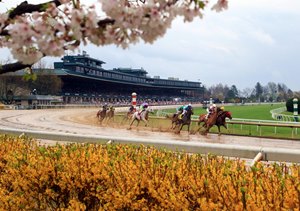Keeneland, Churchill Downs Announce New Safety Reforms


Keeneland and Churchill Downs announced Feb. 27 that major reforms in racing and training policies will be implemented to strengthen safety protocols at both Kentucky racetracks.
The tracks will mandate veterinary inspections prior to workouts and race entry, and they have enhanced their reporting and transparency requirements for trainers and attending veterinarians involved with participating horses.
Also planned this year is the banned race-day use of the anti-bleeding medication furosemide—commonly known as Lasix—in all 2-year-old races at the Kentucky tracks, proceeding with a medication phaseout cleared with the Kentucky Horse Racing Commission last year. This ban begins with the 2020 spring meet that opens April 2 at Keeneland, which is followed by the 2020 spring meet at Churchill Downs starting April 25.
The safety changes will become effective with the opening of the stable areas at Keeneland and Churchill Downs. According to a joint release from the two tracks, trainers and attending veterinarians must agree to the following conditions in order to participate at either track:
-
A trainer is not permitted to enter a horse in any race unless the horse has been found fit to race by the attending veterinarian during the three days immediately prior to entry;
-
A trainer is not permitted to work a horse unless the horse has been found fit to work by the attending veterinarian during the five days immediately before the work.

These initiatives mirror, in part, safety and veterinary protocols that were established in California after a rash of equine fatalities at Santa Anita Park last winter and spring. Horses there also have to undergo frequent veterinary evaluations and must be approved for workouts.
"Initially, people half-joked and half-mocked California trainers—about what we had to go through. I told them, 'Don't laugh too hard because this is your future. It's coming sooner rather than later,'" said Eoin Harty, the president of California Thoroughbred Trainers who races at Santa Anita, as well as other jurisdictions, including Kentucky.
Multiple trainers with sizable strings on the Kentucky circuit declined to comment on the announcement, though another, Mike Maker, said he was supportive of the initiatives.
"Anything that proves a safer environment for these athletes and gives the public a better perception of this wonderful sport is a bonus in my book," he said. "If it saves one horse from injury, it should be deemed a success."
Harty said trainers have become accustomed to the protocols in California, though the regulations can be nuisances.
"It’s a pain in the ass, to be honest. But it’s probably a necessary evil. It forces you to have an extra look at your horse," he said. "Nobody can afford to have an avoidable injury on the racetrack. If this is what it takes—or one of the things that it takes—then so be it."
California has seen a decline in the rate of catastrophic injuries since increased veterinary scrutiny was mandated, one of the numerous factors Harty believes has improved equine safety there.
In other measures announced by Churchill Downs and Keeneland, trainers and attending veterinarians are obligated to inform the equine medical director at the appropriate racetrack and the KHRC of any changes in a horse's fitness after an examination has been conducted.
Additionally, all horses at Keeneland and Churchill Downs will be subject to veterinary inspections by the tracks' respective equine medical directors and other veterinary monitoring.
The reforms also apply to horses stabled at The Thoroughbred Center near Lexington and the Churchill Downs Trackside Training Center near Louisville. Keeneland owns The Thoroughbred Center, and Churchill Downs owns Trackside.
Keeneland president and CEO Bill Thomason and Churchill Downs Racetrack president Kevin Flanery said in Thursday's joint statement: "These meaningful reforms further advance our commitment to create the safest possible environment for racing and training. Racetracks, horsemen, and the veterinary community share a responsibility for the welfare of our human and equine athletes and to promote the sport for generations of fans to come."
Both Keeneland and Churchill Downs are members of the Thoroughbred Safety Coalition, a group that includes the New York Racing Association, The Stronach Group, Del Mar, and the Breeders' Cup. Upon its formation last year, the coalition stated its desire to advance equine welfare measures.
According to data on its website, Keeneland experienced five fatalities from racing during its short 17-day meet last fall. On closing day Oct. 26, animal welfare activists protested outside its gates, just as protesters regularly do outside Santa Anita.
In meetings with regulators in 2019, Kentucky's Thoroughbred racetracks supported sweeping medication reforms, including the Lasix ban, adopted by the Kentucky Horse Racing Commission in late 2019.
